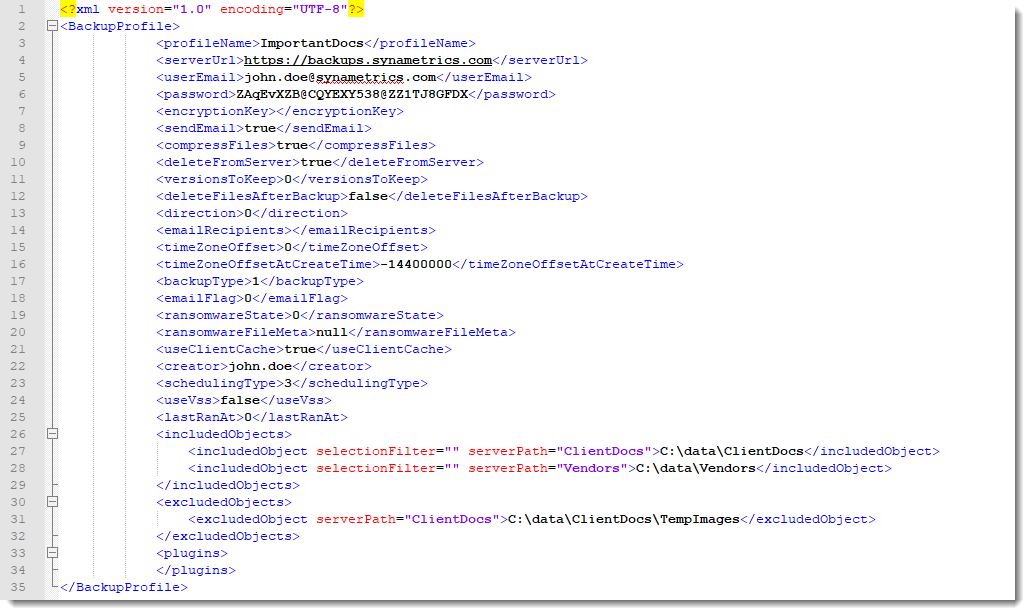Synametrics Technologies
Revolving around the core of technology
Document information
| Document ID: | 5212 |
|---|---|
| Subject: | Syncrify Profile File - Explained |
| Creation date: | 5/9/18 12:21 PM |
| Last modified on: | 12/13/18 12:07 PM |
Syncrify Profile Explained
A profile defines a job in Syncrify. It contains what to backup and when to do it. This information is saved in an XML file that is stored in the Data Folder on the machine running Syncrify Client. This page explains the contents of this XML file, in case you need to modify the file manually.The following image displays a sample profile file.

The name of this profile is ImportantDocs. As result, the actual file name will be
ImportantDocs.syncrify. Following
table describes each node in the XML file and its purpose.
| Node Name | Description |
|---|---|
profileName |
Name of the profile. This must match with the file name and the value is case-sensitive. |
serverUrl |
URL of the server. Note that a URL must have a protocol (either HTTP or HTTPS), host name and port. |
userEmail |
Login ID, which is typically an email address. |
password |
Encrypted version of the password. If you're modifying this field manually, type the password in clear. Syncrify Client will encrypt the value next time it is saved. This trick only works for passwords less than 16 characters long. |
encryptionKey |
Value used for encryption. Do not modify this manually. Use Syncrify Client GUI to change this value. |
sendEmail |
true|false. An email is sent at the end of backup if set to true. |
compressFiles |
true|false. If true, compression is used during backup. |
deleteFromServer |
true|false. If true, files will be deleted from the destination when source files are deleted. |
versionsToKeep |
This should be either 0, indicating versioning is disabled, or 10000000 for versioning is enabled. |
deleteFilesAfterBackup |
true|false. If true, files will be deleted from the client's end once backup is over. DO NOT change this to true unless you really want to remove files on the source machine. |
direction |
0|1|2. Signifies the direction of backup. 0 means Client-to-Server, 1 means Two-way-sync, 2 means Server-to-Client. |
emailRecipients |
Email address where reports are sent. If blank, reports will be sent to the address specified for login ID. |
timeZoneOffset |
Not used anymore. This must be 0. |
timeZoneOffsetAtCreateTime |
Not used anymore. Leave this at 0. |
backupType |
1|2|3. 1 for Delta Copy, 2 for Simple Copy and 3 for Smart Copy. |
emailFlag |
0|1. If set to 1, email will only be sent if an error occurs. |
ransomwareState |
0,1,2,3. 0 means RWP is not initialized or was recently reset. 1 means active, 2 is for internal use, 3 means disabled. Do not modify this value to anything other than a 0 or 3. |
ransomwareFileMeta |
Holds the last modified date, size and MD5 signature of the RWP bait file. Do NOT modify this field. Instead, leave this blank and change
ransomware field to 0. Syncrify Client will populate this field on the next backup. |
useClientCache |
true|false. If true, folder cache is used. |
creator |
User name who created this profile. |
schedulingType |
1|2|3. Signifies the value for scheduler. 1 means Daily, 2 means Interval and 3 means disabled. |
schedulerDays |
Bitmap containing the days for which a backup is scheduled. For example, if the backup is scheduled for Sunday, Tuesday and Thursday, the binary value for this will be 0010101 or 21 in decimal. A 127, which translates into 1111111 into binary, means a backup is scheduled for every day. |
schedulerMinutes |
When schedulingType is 1, this specifies the number of minutes since midnight. For example, if your goal is to run a backup
at 8 PM, this should be 20 (hours) x 60 or 1200. When schedulingType is 2, this value specifies the interval in minutes. |
useVss |
true|false. If true VSS will be enabled. Check this page for details. |
lastRanAt |
Holds the value when backup was run the last time. You should not modify this value manually. |
includedObjects |
Holds one or more includedObject nodes. |
includedObject |
Contains the path of a top-level folder. This node has two parameters:
|
excludedObjects |
Holds one or more excludedObject nodes. |
excludedObject |
Holds the path within a top-level folder that should be excluded from backup. This node contains one parameter:
|
plugins |
Holds one or more plugin nodes. |
plugin |
Holds information about Plugins. Every plugin is different and therefore, it is recommended not to add/modify these nodes manually. |
Add a comment to this document
Do you have a helpful tip related to this document that you'd like to share with other users?
Important: This area is reserved for useful tips. Therefore, do not post any questions here. Instead, use our public forums to post questions.
